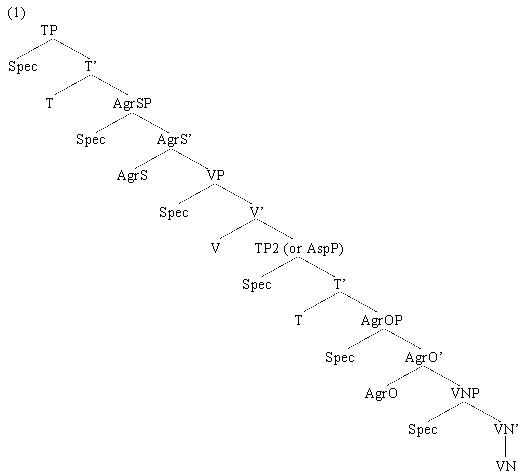
A Split VP was originally proposed by Larson (1988) to deal with double object constructions. Since then, similar structures have been used to describe phenomena in various languages, particularly the Malayo-Polynesian languages (Travis 1991) and the Celtic languages (Guilfoyle ms; Carnie 1995). The "Split VP Hypothesis" (SVH) claims that verbal projections are bipartite, that is, a full verb phrase is a combination of two projections. In addition, in order to account for some of the facts of Irish, it has been suggested that the head of the lower projection of the bipartite structure is a "verbal noun" (VN). The VN has both nominal and verbal properties, and, in Irish, can surface without the higher VP. In combination with the structure of functional categories in Irish, Carnie (1995) presents the tree in (1) as the full structure of the Irish VP. This tree structure accurately and elegantly accounts for a great many facts of these languages as well as typological differences between dialects of Irish. The implication of this version of the SVH is that this structure is universal.
In this paper, I explore how the SVH and VNP analyses can account for verbal structures in
Japanese. Section 1. contains a brief outline of some background characteristics of Japanese,
particularly Japanese particles. The base-generated position of the subject is of great importance
in the formulation of the SVH, and so in section 2., I discuss the controversy surrounding this
issue, concluding that the SVH is the most advantageous analysis to adopt. In section 3. I explain
the arguments behind the proposal that Japanese has few, if any, functional categories (Fukui
1986; Fukui and Speas 1986) and how that proposal affects Japanese structure with regards to
the SVH. In section 4. I discuss the lexical category "VN" as it is found in Irish and explore
elements in Japanese that exhibit similar cross-categorial properties: i) the stem form of the verb,
ii) the light verb construction, and iii) the nominal predicate. I then demonstrate that the VNP
analysis provides a unified structure for all of these superficially diverse elements. In order to
extend the validity of the VNP analysis in Japanese, in section 5., I show how it can accurately
account for the passive and causative constructions as well as predict the grammaticality of
passive + causative and causative + passive combinations. In section 6. I conclude my findings.
